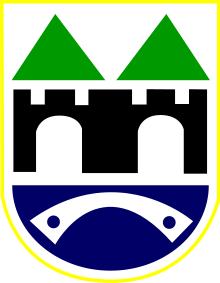Muslihudin Čekrekčija Mosque
Muslihudin Čekrekčija Mosque is second oldest domed mosque in Sarajevo. Construsted in 1526[1], in the Baščaršija area of the city.[2], at the foot of Kovač (the center of the old trading center of Sarajevo). It is raised in the mahala of Isa-Bey's turn. From the vakufname of the founder of the mosque, we learn that Hajji Mustafa, the son of Ishak, is known to the people as Muslihudin Čekrekčija, her builder. This is also the oldest known original document written in Sarajevo. It was found in the legacy of Muhamed Enver ef. Kadić.
| Muslihudin Čekrekčija Mosque | |
|---|---|
 Muslihudin Čekrekčija Mosque | |
| Religion | |
| Affiliation | Islam |
| Location | |
| Location | Sarajevo |
| Architecture | |
| Type | Mosque |
| Style | Ottoman architecture |
| Funded by | Muslihudin Čekrekčija |
| Completed | 1526 |
| Specifications | |
| Length | 17.90 m. |
| Width | 17.54 m. |
| Dome(s) | 1 |
| Minaret(s) | 1 |
| Minaret height | 32 meters |
| Materials | Stone (limestone, sedra), Turkish brick (pavements), wood, wrought iron, lead and copper sheet |
In the Vakufnam, in connection with the establishment and construction of the mosque, it's written:
"... When a man dies, his work is cut off, apart from trifling: the science that is used, the valued child that brings him and the permanent herbs"
- translation by Mehmed Handžić.[3]
Since 2004, the mosque has been under the protection of Commission to preserve national monuments of Bosnia and Herzegovina. The decision was made by the Commission for the Preservation of National Monuments at the session held from 2 to 8 November 2004 in the following composition: Zeynep Ahunbay, Amra Hadžimuhamedović (Chair), Dubravko Lovrenović), Ljiljana Ševo and Tina Wik, declared the mosque for the National Monument of Bosnia and Herzegovina.[4] Today the links with its commercial past remain, as it is surrounded by shops.
Literature
Mehmed Mujezinović, Islamic Epigraphic of Bosnia and Herzegovina, Book I - Sarajevo, Sarajevo, 1988. Behija Zlatar, Zlatni period Sarajeva: Contributions to the history of Sarajevo, Institute of History, 1997 Alija Bejtić, Streets and squares of old Sarajevo, Sarajevo 1973. Andrej Andrejevic, Islamic monumental art of the XVI century in Yugoslavia - dome mosque, Faculty of Philosophy in Belgrade, Institute for the History of Art, Belgrade, 1984
References
- http://old.kons.gov.ba/main.php?id_struct=50&lang=4&action=view&id=2511
- daenet d.o.o. (2014-06-28). "Grad Sarajevo : Islamski sakralni objekti". Sarajevo.ba. Archived from the original on 2016-03-10. Retrieved 2016-07-17.
- "Archived copy". Archived from the original on 2015-04-03. Retrieved 2019-04-24.CS1 maint: archived copy as title (link)
- http://aplikacija.kons.gov.ba/kons/public/uploads/odluke_bos/Sarajevo_Magribija%20dzamija%20BH.pdf%5B%5D

